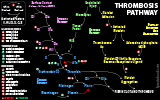Clotting Pathway, Clotting Cascade, Coagulation Pathway, Clotting Factor, Blood Coagulation, Blood Clotting, Clot Formation, Hemostatic Function, Hemostasis, Coagulation Factor, Factor II, Prothrombin, Factor III, Tissue Thromboplastin, Factor V, Factor VII, Factor VIII, Factor IX, Factor X, Factor XI, Factor XII, Factor XIII, Fibrin, Thrombin
- See Also
- Physiology
- Clotting Factors
- Numbered Factors (typically shown with roman numerals)
- Factor 1: Fibrinogen
- Factor 2: Prothrombin
- Factor 3: Tissue Thromboplastin
- Factor 4: Calcium
- Factor 5: Proaccelerin (Ac Globulin)
- Factor 7: Proconvertin
- Factor 8: Antihemophilic Factor A (Thromboplastinogen)
- Factor 9: Antihemophilic Factor B (Christmas Factor)
- Factor 10: Stuart Factor
- Factor 11: Antihemophilic Factor C
- Factor 12: Hageman Factor
- Factor 13: Fibrin Stabilizing Factor
- Other factors
- Von Willebrand Factor (carries Factor 8)
- HMW Kininogen (Fitzgerald Factor)
- Prekallikrein (Fletcher Factor)
- Platelets
- Fibrin
- Thrombin
- Physiology
- Clotting Factor Synthesis
-
Liver Hepatocytes (decreased synthetic function in Cirrhosis, Acute Hepatic Failure)
- Fibrinogen
- Prothrombin
- Factor 5
- Factor 7
- Factor 9
- Factor 10
- Factor 11
- Factor 12
- Protein C
- Protein S
- Antithrombin
-
Liver Sinusoidal Endothelial Cells (levels not related to hepatic synthetic function)
- Factor 8
- Von Willebrand Factor
- Physiology
- Hemostasis Mechanisms
- Physiology
- Clotting Pathways
- Initiators of the Clotting Cascade
- Intrinsic Clotting Pathway
- Initiated by Negatively charged surface of foreign material or from damaged Red Blood Cells
- Pathway is relatively slow (minutes to form blood clot)
- Factor XII to Factor XI to Factor IX and Factor VIII which trigger conversion of Factor X to Xa
- Factor Xa then proceeds into the common pathway, generating Thrombin and then Fibrin
- Extrinsic Clotting Pathway
- Initiated by disrupted cell membranes
- Damaged cells (including vascular endothelial cells) release Tissue Thromboplastin
- Pathway is relatively rapid with Blood Clotting occuring within 15 seconds
- Factor VII, Factor V and Calcium combine to trigger conversion of Factor X to Xa
- Factor Xa then proceeds into the common pathway, generating Thrombin and then Fibrin
- Intrinsic Clotting Pathway
-
Common Clotting Pathway follows above initiators
- Antagonized by Clotting Pathway Inhibition
- Prothrombin => Thrombin (catalyzed by Prothrombin activator)
- Fibrinogen => Fibrin (catalyzed by Thrombin)
- Fibrin combines with Platelets, plasma factors and Red Blood Cells to form blood clot
- Factors
- Activation
- All of these Clotting Factors (both pro-coagulant and Anticoagulant) are Vitamin K Dependent
- Vitamin K is required for carboxylation of terminal ends of coagulation Proteins
- Without carboxylation, Clotting Factors/Proteins are not activated and Clotting Cascade does not occur
- Warfarin inhibits the cyclic interconversion of Vitamin K to a reduced form
- Keeps Vitamin K and dependent factors inactive
- Procoagulant Factors (Mnemonic: "1972")
- Factor 10 (half life 36 hours)
- Factor 9 (half life 24 hours)
- Factor 7 (half life 7 hours)
- Factor 2 (half life 50 hours)
- Anticoagulant Factors
- Activation
- Labs
- Background: Blood collection
- Glass Blood Collection Tubes will trigger the Intrinsic Clotting Pathway
- Glass Blood Collection Tubes therefore contain Anticoagulants to prevent Blood Clotting
- Calcium (Factor 4) is a Cofactor in both the extrinsic and intrinsic pathways
- Some glass collection tubes contain Calcium binders (e.g. oxalate, citrate) to prevent clotting
- Glass Blood Collection Tubes will trigger the Intrinsic Clotting Pathway
-
Partial Thromboplastin Time (PTT)
- Measures intrinsic pathway
- Prolonged by
-
Prothrombin Time (PT)
- Measures extrinsic pathway
- Affecting both ProTime and Partial Thromboplastin Time
- Factor X
- Factor V
- Prothrombin
- Fibrinogen
-
Thrombin Time
- Measures only common pathway
- Causes
- Coagulation Disorder etiologies
- Associated Conditions
- See Bleeding Disorder
- See Thrombophilia (Hypercoagulability)
- Resources
- Coagulation (Wikipedia)
- References
- Goldberg (2014) Clinical Physiology, Medmasters, Miami, p. 61-5
- Palta (2014) Indian J Anaesth 58(5): 515-23 +PMID: 25535411 [PubMed]
- Smith (2015) Crit Rev Biochem Mol Biol 50(4): 326-36 +PMID:26018600 [PubMed]

